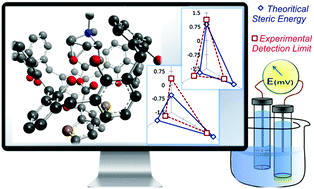当前位置:
X-MOL 学术
›
New J. Chem.
›
论文详情
Our official English website, www.x-mol.net, welcomes your feedback! (Note: you will need to create a separate account there.)
Experimental validation of a computationally-designed tiotropium membrane sensor†
New Journal of Chemistry ( IF 3.3 ) Pub Date : 2018-09-06 00:00:00 , DOI: 10.1039/c8nj03507e Ali M. Yehia 1, 2, 3, 4, 5 , Soad E. Abo-Elhoda 5, 6, 7, 8, 9 , Nagiba Y. Hassan 1, 2, 3, 4, 5 , Amr M. Badawey 1, 2, 3, 4, 5
New Journal of Chemistry ( IF 3.3 ) Pub Date : 2018-09-06 00:00:00 , DOI: 10.1039/c8nj03507e Ali M. Yehia 1, 2, 3, 4, 5 , Soad E. Abo-Elhoda 5, 6, 7, 8, 9 , Nagiba Y. Hassan 1, 2, 3, 4, 5 , Amr M. Badawey 1, 2, 3, 4, 5
Affiliation

|
In this study we draw parallel computational and experimental data for potentiometric sensor assembly. Tiotropium (TIO) is a long acting anticholinergic agent and is used for maintenance treatment of chronic obstructive pulmonary disease. Systems comprising different ion exchangers with or without ionophores were theoretically and practically evaluated for TIO membrane sensors. Different phenyl borate derivatives as cation exchangers along with calix[8]arene or (2-hydroxypropyl)-β-cyclodextrin as ionophores were compared in terms of steric energies and detection limits. Tetrakis-[3,5-bis(trifluoro-methyl)phenyl] borate and calix[8]arene sensors provided the lowermost steric energy (−30.63 kcal mol−1) as well as detection limit (1.6 × 10−7 mol L−1) for TIO analysis. Correlation between the normalized values of theoretical energies and practical detection limits was reasonably close; therefore, molecular mechanics offers a viable alternative to experimental optimization of sensor assembly. The optimized sensor showed a Nernstian slope of 59.5 mV decade−1 in a linear range from 3.2 × 10−7 mol L−1 to 1 × 10−2 mol L−1. This sensor could sufficiently discriminate the target ion from N-methyl-scopine as a possibly interfering official impurity. Selectivity was enhanced by about one order of magnitude compared to other sensors. The proposed sensor was successfully used for the determination of TIO in Spiriva® inhalation powder and compared favourably with the official method.
中文翻译:

计算设计的噻托铵膜传感器的实验验证†
在这项研究中,我们绘制了电位传感器组件的并行计算和实验数据。噻托溴铵(TIO)是一种长效抗胆碱能药,用于慢性阻塞性肺疾病的维持治疗。从理论上和实践上对TIO膜传感器评估了包含带有或不带有离子载体的不同离子交换剂的系统。比较了不同的硼酸苯酯衍生物作为阳离子交换剂,以及杯[8]芳烃或(2-羟丙基)-β-环糊精作为离子载体的空间能量和检测限。四- [3,5-双(三氟-甲基)苯基]硼酸盐和杯[8]芳烃传感器提供的最下位的能量(千卡-30.63摩尔-1)以及检测限(1.6×10 -7摩尔大号- 1个)进行TIO分析。理论能量的归一化值与实际检测极限之间的相关性相当接近。因此,分子力学为传感器装配的实验优化提供了可行的替代方法。优化的传感器在从3.2×10 -7 mol L -1到1×10 -2 mol L -1的线性范围内显示59.5 mV October -1的Nernstian斜率。该传感器可以从N中充分区分目标离子-甲基山-碱可能是干扰性官方杂质。与其他传感器相比,选择性提高了大约一个数量级。所提出的传感器已成功用于测定Spiriva®吸入粉中的TIO,并与官方方法相比具有优势。
更新日期:2018-09-06
中文翻译:

计算设计的噻托铵膜传感器的实验验证†
在这项研究中,我们绘制了电位传感器组件的并行计算和实验数据。噻托溴铵(TIO)是一种长效抗胆碱能药,用于慢性阻塞性肺疾病的维持治疗。从理论上和实践上对TIO膜传感器评估了包含带有或不带有离子载体的不同离子交换剂的系统。比较了不同的硼酸苯酯衍生物作为阳离子交换剂,以及杯[8]芳烃或(2-羟丙基)-β-环糊精作为离子载体的空间能量和检测限。四- [3,5-双(三氟-甲基)苯基]硼酸盐和杯[8]芳烃传感器提供的最下位的能量(千卡-30.63摩尔-1)以及检测限(1.6×10 -7摩尔大号- 1个)进行TIO分析。理论能量的归一化值与实际检测极限之间的相关性相当接近。因此,分子力学为传感器装配的实验优化提供了可行的替代方法。优化的传感器在从3.2×10 -7 mol L -1到1×10 -2 mol L -1的线性范围内显示59.5 mV October -1的Nernstian斜率。该传感器可以从N中充分区分目标离子-甲基山-碱可能是干扰性官方杂质。与其他传感器相比,选择性提高了大约一个数量级。所提出的传感器已成功用于测定Spiriva®吸入粉中的TIO,并与官方方法相比具有优势。



























 京公网安备 11010802027423号
京公网安备 11010802027423号